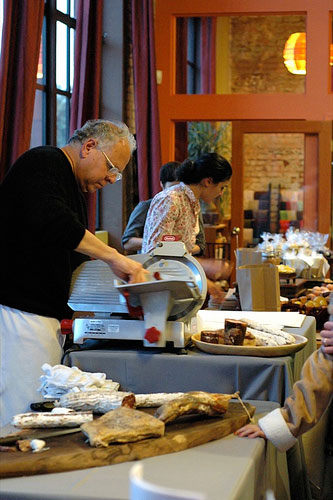In her book The Economy of Cities, the great urban theorist Jane Jacobs praised what she called the “valuable inefficiencies and impracticalities of cities.” To explain her point, she invited readers to consider two examples from 19th century England: Manchester and Birmingham — or as she put it, “Efficient Manchester” and “Inefficient Birmingham.”
As I have written before, efficient Manchester specialized in textiles, building a world-beating industry dominated by a few large, streamlined companies. Inefficient Birmingham, by contrast, housed dozens of different trades. And in place of a few big companies, most of Birmingham’s manufacturing was performed by small organizations employing a dozen or fewer workmen, Jacob writes.
At the time, everyone from free-market economists to Marx himself saw Manchester as the “city of the future” and Birmingham as an obsolete backwater. But reality took a different course. Manchester’s textile industry quickly peaked and collapsed, pressured by lower-cost production in colonial India. The city entered a long economic depression, from which it only emerged after World War II. Meanwhile, Birmingham’s economy grew steadily over the decades and remains robust today.
To me, Jacobs’ Manchester/Birmingham discussion provides a kind of über-fable for city planning and development. Among its lessons: cities shouldn’t specialize in a single product; beware dominant, streamlined enterprises; and nurture small, interdependent businesses that tend to spawn new enterprises rather than swallow up existing ones.
 Chefs Chris Lee and Samin Nosrat, cofounders of the Pop-Up General Store, an informal food marketplace in the Bay Area(Melissa Schneider)Food production seems to me to represent a classic Birminghamian set of activities. It sounds like a single thing, but really it contains a multitude. People eat every day, and they like variety. That means a potentially steady market for a wide range of products. And increasingly in U.S. cities, people like to eat really good stuff made by small-scale artisans with whom they can communicate directly. Restaurants have always served that function to a degree, but there are infinite possibilities outside of the restaurant, with its crushing startup and operational costs.
Chefs Chris Lee and Samin Nosrat, cofounders of the Pop-Up General Store, an informal food marketplace in the Bay Area(Melissa Schneider)Food production seems to me to represent a classic Birminghamian set of activities. It sounds like a single thing, but really it contains a multitude. People eat every day, and they like variety. That means a potentially steady market for a wide range of products. And increasingly in U.S. cities, people like to eat really good stuff made by small-scale artisans with whom they can communicate directly. Restaurants have always served that function to a degree, but there are infinite possibilities outside of the restaurant, with its crushing startup and operational costs.
An article in Wednesday’s New York Times shows that just such a culture is developing in New York. Writes Julie Moskin:
They carry home-grown radishes and red-cooked pork. They transport dozens of empanadas, juggling sheet pans on the G train. They pack boxes of butterscotch cupcakes, Sichuan-spiced beef jerky and grapefruit marmalade. They haul boiled peanuts, ice-grinding machines, sandwich presses and at least one toaster oven painted hot pink.
I’m not sure what “red-cooked pork” is, but I like what Moskin is getting at: in New York City, markets are popping up that link highly skilled, micro-scale food artisans with extremely excited customers. She makes it sound like the warrens of lower Manhattan and Brooklyn bristle with entrepreneurs cranking out delightful empanadas and “logs of butter mashed with wild ramps … gathered in Vermont.”
It’s no accident that the upswell is taking place during an extended economic downturn. The story focuses on an empanada maker named Fabiana Lee with a classic New York story: she’s Korean by way of Argentina. (Her ethnic influences come together in a dish I must try someday: an Argentine-style empanada stuffed with chorizo, glass noodles, and kimchi.) Trained as an interior designer, Lee launched her career in empanadas after losing her regular job in 2009. Rather than idle the hours away while waiting for “real” employment, Lee “has never worked harder,” Moskin reports, as she “tries to build a viable business one bite at a time.”
And she’s not alone. Most of the new food entrepreneurs are, like Lee, “young, college-educated, Internet-savvy, unemployed and hoping to find a place in the food world outside the traditional route,” Moskin writes.
The artisan movement also includes moonlighting restaurant cooks who dream of having their own food business, but don’t want the stress and risk of opening a restaurant. Many such folks are selling their tasty wares at brand new kinds of temporary marketplaces like the Pop-Up General Store, whose offerings include boudin blanc sausages, handmade rigatoni, and chicken stock made from locally sourced, sustainable ingredients, as this San Francisco Chronicle piece reports. The Bay Area boasts several other such guerilla-goods exchanges, like the SF Underground Market, which attracted over a thousand people to its last appearance.
Of course, there are problems. Cooking large quantities in cramped home kitchens is frustrating and time consuming; hauling lovingly prepared food from home to market through New York’s streets or Bay Area traffic is difficult and hard on the product; and, because of the long hours, the economic rewards, despite the high prices people are willing to pay, are minimal.
Then there are the regulatory hurdles. Lee sells her wares at a once-per-month market in the basement of a Brooklyn church, which takes in part of the proceeds. Because of the church’s involvement, she and her fellow market vendors are able to skirt around laws that force food vendors to cook in certified kitchens. However, that will soon change. Writes Moskin:
On May 28, the New York Department of Health confirmed that all food vendors in the city must have a food handling permit, and may use only approved commercial kitchens. Renting space in a commercial kitchen costs about $200 for eight hours. For some vendors like Ms. Lee, who is in the process of getting her permit, that would mean the difference between making a small profit and just breaking even on a day at the market.
So will the artisanal-foods movement be crushed by draconian food safety laws? It needn’t be. One of the lessons that Jane Jacobs taught was that smart city planners should open their eyes and see what’s working well on the ground, and then use policy to bolster those things.
In this case, at a time of high unemployment, we’ve got skilled people bringing new products to market; we’ve got consumers willing to pay a fair price for those products; and a bunch of bottlenecks in between, including regulatory ones. Sounds like what New York City needs to do is invest in an inspected community kitchen, and make it available to its budding food artisans at an affordable price. (San Francisco is lucky enough to have the community supported commercial kitchen, La Cocina, which has enabled numerous low-income Mission district residents and others to become food entrepreneurs.) All sorts of wonderful synergies would become possible — they could group together and buy certain staples, including locally grown produce, in bulk; they could get their products safely and efficiently to market — say, by banding together to rent a truck once a week. And so on.
Of course, New York is no Manchester. Its economy has always been pretty diversified and friendly to small businesses, compared to most American cities, at least. Still, its economy gets hit hard when one of its economic pillars, like the financial industry, suffers a plunge. In these grim economic times, any city can gain from maximizing its Birmingham-like qualities. If ambitious food entrepreneurs like Lee can find ways to succeed, the city will increase its economic resiliency — and the availability of delicious food. Rather than stamp them out with regulations, city officials should be figuring out how to leverage their energy and skill.




